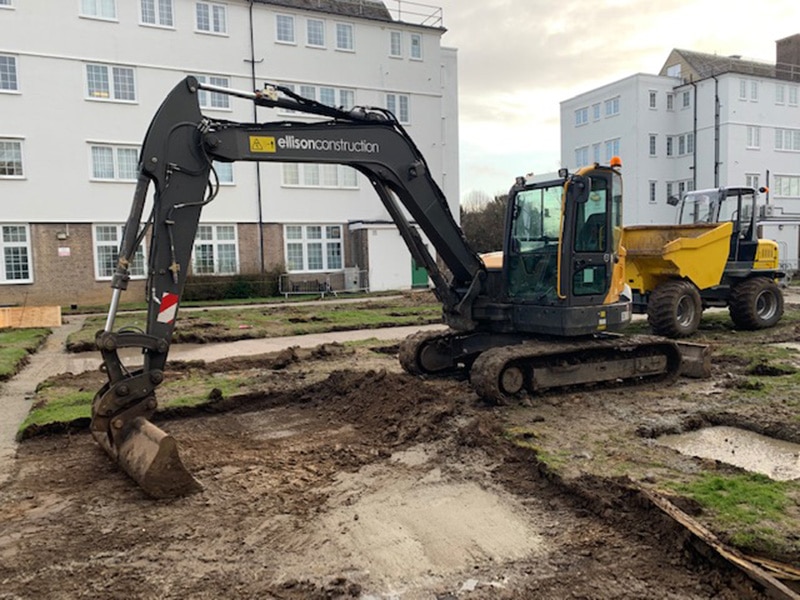Land Remediation vs Disposal: When to remove vs contain asbestos in soil
When many of us think about asbestos – the fibrous silicate mineral that has been banned in the UK since 1999, which was formerly extensively used – we might initially think of the many different asbestos products that are still present in many buildings today.
Examples of such asbestos-containing materials (ACMs) include asbestos cement roofing sheets, asbestos insulating board (AIB), and asbestos textured coatings.
However, there are also various circumstances in which ACMs or loose asbestos fibres can find their way into soil. If you have arranged for the necessary investigations – such as an asbestos contaminated land survey – you may know that asbestos is present in soil at a site for which you are responsible.
In such a situation, though, it may not be immediately obvious to you what actions you should take to manage the contaminated ground. So, in this article, we have looked at two possibilities – having the asbestos removed, or leaving the material in place and carrying out an alternative form of remediation on it.

What are the risks of asbestos-contaminated soil?
With the inhalation of asbestos fibres having long been recognised as a major health risk – and asbestos-related disease still leading to around 5,000 deaths per year in the UK – it is crucial to not underestimate the dangers asbestos-contaminated soil can present.
Below are some factors that can make it so dangerous:
- When asbestos is buried in land or soil, it is more likely to be damaged, fragmented, and fibrous, than is the case for ACMs that are left untouched in an intact building. This can bring a heightened likelihood of any future disturbance of the soil causing the release into the air of loose asbestos fibres.
- If asbestos-contaminated soil is not identified and/or treated correctly, and heavy machinery is later used on the site for such purposes as excavation and land works, there can be great potential for asbestos fibres to become airborne.
In the event of such releases of asbestos fibres, the health of both on-site workers and the general public could be put at risk.
This is before one even considers the legal and financial risks of asbestos in soil for those who are responsible for managing such sites. A failure to comply with the UK’s stringent health, safety, and asbestos laws can lead to fines, project delays, and liabilities.
What are the UK regulations for managing asbestos in soil?
Landowners and contractors that play a part in managing asbestos-contaminated soil will need to ensure they comply with relevant regulations, such as:
- The Control of Asbestos Regulations 2012 (CAR 2012)
This is the overarching legislation setting out how asbestos must be managed at non-domestic sites in Great Britain. CAR 2012 introduces the concept of the “dutyholder”, who is legally obliged to assess and manage risks posed by asbestos in soil.
- The Environmental Protection Act 1990
This Act defines contaminated land as land that is causing, or that could cause, significant harm to people, property, or protected species, or pollution of controlled waters because of substances in or under it. Asbestos is just one example of such a potential substance.
In accordance with this legislation, a risk-based approach must be taken to the identification and remediation of land where contamination presents an unacceptable risk.
In England and Wales, all asbestos waste is defined as “hazardous waste” when it contains more than 0.1% asbestos. As we have previously written about, such waste is subject to the Hazardous Waste Regulations 2005, with a Hazardous Waste Consignment Note needing to be completed.
How do you decide between asbestos removal and remediation?
In case you’re still a little confused about what we mean when we talk about “asbestos removal” and “asbestos remediation”, you might be interested in consulting our in-depth guide to the distinctions between these terms.
In short:
- Asbestos removal involves ACMs being eliminated from a particular site, such as land where asbestos fibres are present in the soil.
- Asbestos remediation refers to the management and reduction of asbestos hazards. Although the removal of ACMs is a form of asbestos remediation, the broad term “remediation” can also encompass other approaches, such as the encapsulation of ACMs with a protective sealant, or soil stabilisation with binding agents.
So, that leaves you with a fundamental question. If you are responsible for asbestos-contaminated soil, which option – out of removal or remediation – would be the best choice for your site?
Careful consideration of the below factors will help you decide:
- The extent of the contamination: is the situation at your site a small and localised instance of asbestos contamination, or is there a much more widespread asbestos presence? A remediation approach like encapsulation might make sense if the asbestos is restricted to a single, relatively modest, and easily manageable location.
- The soil disturbance risks: how likely is it that the asbestos fibres will be disturbed in the future? For example, you may be likelier to choose remediation over removal if the probability of future disturbance is low.
- Land use considerations: do you expect the site to be developed, or do you anticipate the land being left undisturbed? Any imminent plans for the wholesale development of the site will probably render the similarly wholesale removal of asbestos-contaminated soil a much more attractive and suitable option.
- Cost-effectiveness: the “upfront” cost of an asbestos remediation method such as encapsulation may be cheaper than arranging for the asbestos-contaminated soil to be removed. However, this might not make it the more cost-effective option in the longer term, given that if asbestos is still present in the soil, it will need to be managed and maintained on an ongoing basis.
When should you remove asbestos-contaminated soil?
Below are examples of scenarios in which the full removal of asbestos-contaminated soil from your site is likely to be the best option:
- If asbestos fibres are already airborne or otherwise present at dangerous levels
- When plans to redevelop the land necessitate excavation, and therefore potential exposure to asbestos
- The level of asbestos contamination is too high to allow for safe encapsulation of the ACMs
If you do ultimately decide to have the asbestos-contaminated soil removed from your site, there are – broadly speaking – two ways in which this can be done:
- Asbestos litter picking, which is likely to be the preferred option when the only identified asbestos on the site is on the surface, and the asbestos is in larger visible fragments
- The full removal of the contaminated soil and waste, which is then transported to a licensed asbestos landfill site for disposal. This option tends to be chosen in cases where the asbestos is fragmented, fibrous, and located beneath the surface.
The price of excavation, transport, and the licensed disposal of asbestos-contaminated soil typically comes to around £100 to £250 per tonne. For more information about the costs involved in asbestos disposal see our comprehensive cost guide.
When should you remediate (contain) asbestos in soil, instead of removing it?
For the purposes of this section, we are interpreting “remediation” as meaning asbestos management techniques that involve the ACMs being left in place (in other words, courses of action other than the removal of asbestos).
Below are examples of situations where remediation can be a viable alternative to removal:
- If the asbestos is bound in non-friable materials, such as cement fragments
- When soil disturbance is minimal, given that this reduces the likelihood of asbestos fibre release
- When the way in which the land is used (or is set to be used) does not require excavation, as is the situation with agricultural and greenfield sites
Presuming you decide in favour of remediation rather than the removal of asbestos from your land, you might give serious thought to these common asbestos soil remediation techniques:
- Capping and encapsulation: this refers to the practice of covering asbestos-contaminated soil with clean layers of soil or hardstanding
- Soil solidification and stabilisation: this remediation option involves the use of chemical treatments to lock asbestos fibres in place
- On-site containment cells: with this approach, barriers are constructed to prevent the asbestos fibres migrating beyond the area of the land where they were spotted.
To reiterate a statement we made earlier, asbestos remediation can be attractive from a cost perspective compared to asbestos removal. We have previously written about how encapsulation, for instance, usually costs approximately 25% as much as removal.
What are the pros and cons of asbestos soil removal vs remediation?
Here is a “cut out and keep” summary of the advantages and disadvantages of arranging for the removal or remediation of asbestos in soil:
| Factor | Asbestos removal | Asbestos remediation |
| Risk of exposure | Higher during excavation | Lower if left undisturbed |
| Compliance | Must meet hazardous waste transport regulations | Requires long-term monitoring |
| Cost | Higher upfront costs (£100 to £250 per tonne) | Lower initial costs, but monitoring is required |
| Environmental impact | More disruption and waste generation | Less soil disturbance and lower impact |
| Best for… | Redevelopment sites | Agricultural or undisturbed land |
Final thoughts regarding asbestos land remediation vs disposal
There are right ways and wrong ways to deal with asbestos-contaminated soil at a site for which you are responsible. By hiring licensed asbestos professionals to carry out inspections and risk assessments at your site, and creating an asbestos management plan, you can help to ensure the safe and legally compliant management of asbestos in your soil.
Unfortunately, however, certain mistakes are frequently made by individuals and organisations dealing with asbestos in soil. These include – but are not limited to – failing to conduct a proper asbestos soil survey, attempting to remove the asbestos without a licensed contractor, and/or ignoring compliance requirements and legal obligations.
Such risks underscore the importance of seeking expert advice for site-specific asbestos management. A proper risk assessment is crucial, too, not least given that it will inform the decision you make between removal and remediation for the asbestos at your site.
Contact one of our licensed asbestos consultants today, to benefit from a professional site assessment and compliance guidance. We can be reached via phone or email.

Written by Jess Scott
Jess Scott has been an all-round asbestos consultant since 1996. That’s nearly 3 decades of asbestos knowledge. He spends his time sharing that knowledge with the team at Oracle and with their clients. Jess's goal is, and always has been, to use my expertise in helping people to comply with the law. This legal compliance ultimately helps to protect everyone from the harmful effects of asbestos. Jess has acted as an asbestos expert witness in legal cases and is involved in many asbestos educational activities throughout the UK.
